|
|
Post by earlee on Oct 30, 2005 8:24:44 GMT 10
INTRODUCTION TO THIS THREAD:This thread was commenced by Earlee in October 2005. Since then numerous posts have been added with information about various brands of tow couplings. The posts that follow have been indexed by Cobber. To go to the TOW COUPLING INDEX CLICK HERE Don Ricardo for the moderating team
Following is Earlee's initial post: This is the old coupling that I have just replaced on my bondwood van. It has a one and seven eighths inch ball with a bolt thread sticking out the top. This coupling will not fit a standard 2” ball so was a bit of a pain changing it from car to car, and wasn’t really sure about the integrity of the bolt. I replaced it with the standard 2” over ride coupling which sticks out from the drawbar a little bit , making the car less likely to hit the van on sharp turns. What other types of couplings have people got? Later, much later, we discovered that this is a Henderson's coupling. 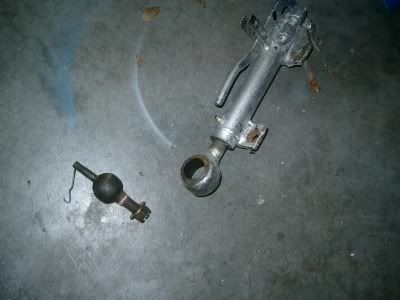
|
|
|
|
Post by cobber on Oct 30, 2005 13:39:15 GMT 10
A good subject Earlee, I had the same coupling you have shown on the van I have advertised as “free to a good home”. The wing nut on the end of that bolt you didn’t trust actually broke off during my efforts to unscrew it. It took us a long time to get evidence that the above coupling was made by "Hendersons"..see reply #146 At Coledale I took photos of some of the couplings that were there. Perhaps the owners of these could comment on their impressions of each of them? I didn’t get ‘em all--run out of film.  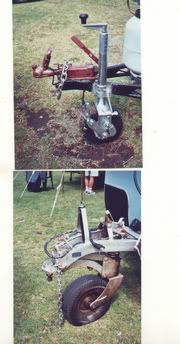 Plus a few adds from Motor Manual magazine of the 50’s era. 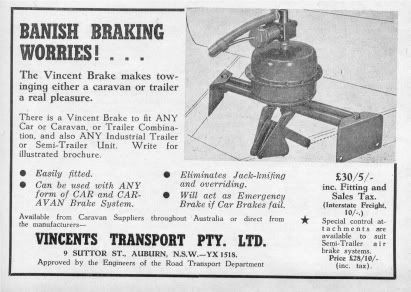 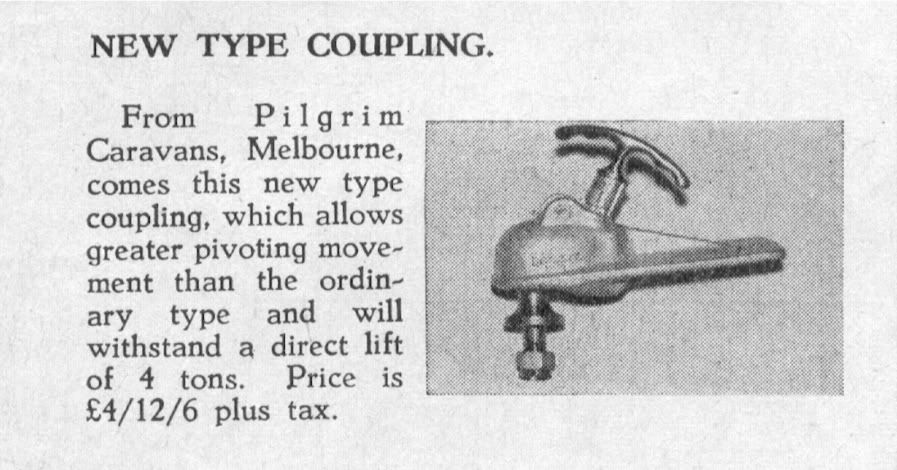  Cobber. |
|
|
|
Post by cobber on Feb 27, 2007 16:04:14 GMT 10
With just a little bit of prompting from Don I thought it would be good to resurrect this thread by putting the “Brockhouse & Co.” coupling that is on my 1936 caravan on here. The patent was granted to Brockhouse & Co of West Bromwich, England in 1932. There was a slight improvement to the design to be able to take up wear between the ball and the socket in 1935. Another improvement to the patent was applied for in 1937 to provide for a hand brake. There was another improvement in 1939. My coupling only has the 1935 improvement when I got it so the information has been helpful in verifying the age of ol’ 36. I have since added a hand brake of my own design  The coupling surprisingly fits a 50mm ball. 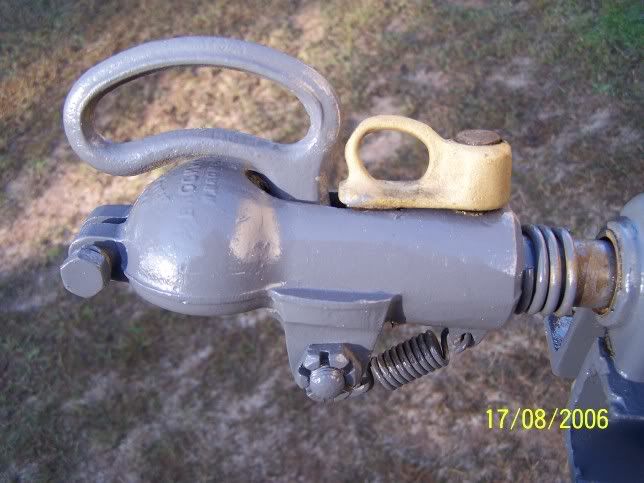 Coupling fitted to override brake & my hand brake mod. The jockey wheel is not a bad set up..I think it is a 1950s addition supplied by "Henderson's" who supplied prefabricated caravan frames. 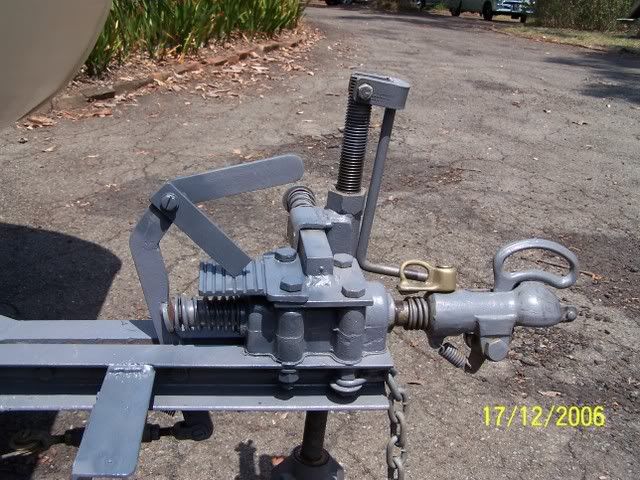 Cobber. |
|
|
|
Post by cobber on Mar 1, 2007 8:02:30 GMT 10
313royal, Boiling it down to basics...according to my understanding, and experiences with the RTA in NSW, and I gather it works the same in other states (correct me if I'm wrong on this point people) if it is your desire to keep the van original you are allowed to keep the original coupling if it is in good working order. In N.S.W the RTA say couplings have always been branded with a makers name and weight capacity so they insist these markings appear. We know not all vintage couplings had these markings originally..so without them you might get a knock back. Makers name and weight capacity have been known to miraculously appear under paint when it is removed   Your common sense then comes into play. I would feel a bit nervous using that coupling that earlee opened this thread with, all the others would suit me, but I would fit a strong safety chain (even with a new coupling)...just in case. Cobber. |
|
|
|
Post by kingy on Mar 1, 2007 9:00:27 GMT 10
Hi All
As far as i understand it, if a trailer gets reregistered or registered for the first time, the coupling MUST have manufactures name and the load capacity stamped on the coupling. These are usually done within the casting, and i'm sure it's only a new law (in NSW)
When i registered my van, it was all they knocked it back on.
I also think it's a case of who you are lucky or unlucky to come accross on the day of rego.
Kingy
|
|
|
|
Post by Don Ricardo on Mar 19, 2007 23:31:03 GMT 10
G’day Cobber and everyone, Thanks Cobber for resurrecting this thread. Sorry for not responding for a while – just haven’t had the time to get something together unfortunately. Thanks also for posting the photo of the coupling on Ol’ 36. What I found so interesting is that the design in many ways doesn’t seem to be a world away from a modern coupling. The ‘ball cup’ looks to be similar and the mechanical brake mechanism seems to function in a similar way, as far as I can see (correct me if I’m wrong). However the way that the coupling is actually constructed is more apparent, ie you can see how it’s put together. I’m assuming from your comments that the actual braking mechanism is original, and that it is just the ratchet system for the handbrake that you’ve added? I am also interested in the construction of the worm and nut arrangement for the jockey wheel. Do you know if it is common for its time? Is the jockey wheel cast iron or rubber tyred? As I’ve mentioned in other posts, the tow coupling used by Don for their 1934-1955 models were different from the norm, because the tow ball was a permanent part of the head of the A-frame. This is visible in some of the pics which have been posted on the forum, but I’ve taken some photos of our van which focus particularly on the A-frame and the jockey wheel, which I hope people will find of interest. 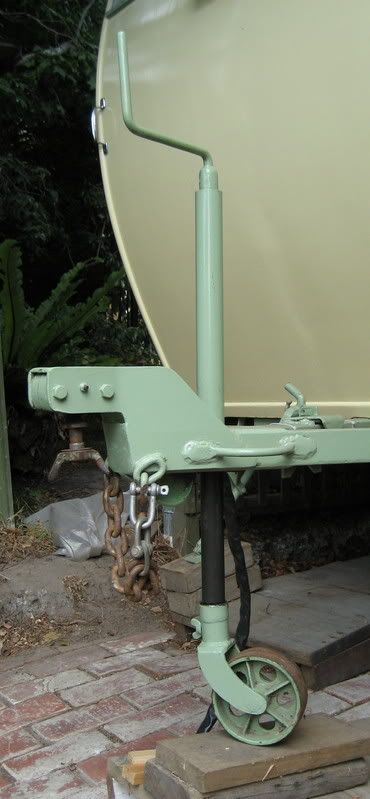 The jockey wheel mechanism is welded into the apex of the A-frame just ahead of the head of the frame. (I am making up terminology as I go here, which I trust is understandable. No doubt there are proper technical terms for each part!) The chains and level ride brackets, which are visible in this photo, are of course later additions. There is no handbrake – indeed there were no brakes on the van originally. Apparently brakes (“over-run or automatic [not sure of the difference?] or vacuum operated”) were an optional extra, although I’ve never seen them. (What about you Mark?) Cobber, you said you added a handbrake to Ol’ 36 because you were concerned about her running away. Our solution is a few redgum blocks we carry in the boot of the car for this purpose. I guess they qualify as handbrakes – we get them out and chock the caravan wheels by hand!! 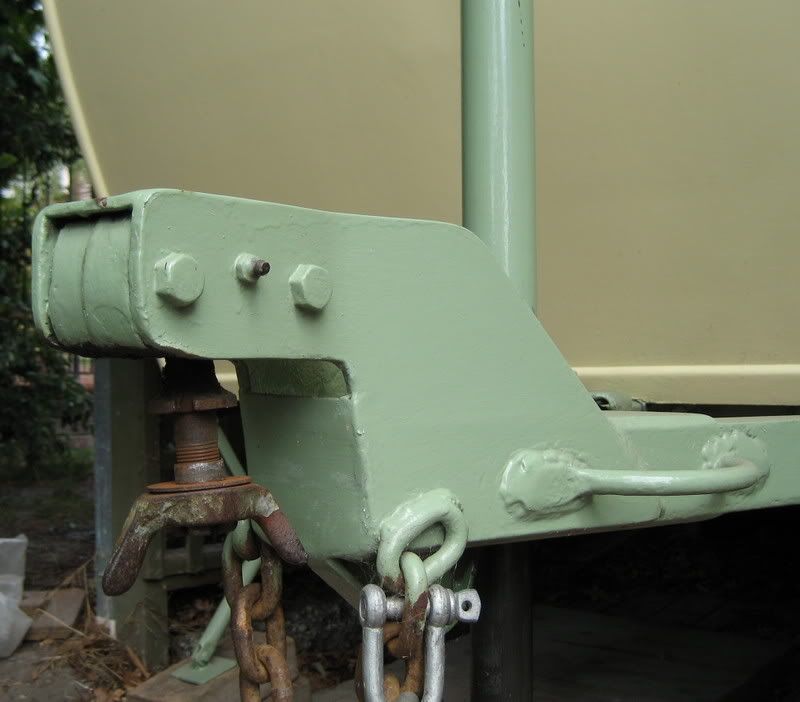 This photo shows the head of the A-frame in more detail, including the grease nipple used to keep the tow ball greased. The wing nut is original equipment and has survived many severe beltings from a mallet at the end of a piece of 2-by-1 to get the nut tight on the shank. You will also note a small ring sitting on top of the wing nut and washer. This ring is not original equipment but prevents the shank of the tow ball moving around in the tongue of the tow bar. This ring has been given a very technical name by our family: “the wedding ring”! We all know about the wedding ring, because it has a habit of wandering off entirely on its own volition. The cry of “where’s the wedding ring” is one of the sacred parts of our caravaning ritual. 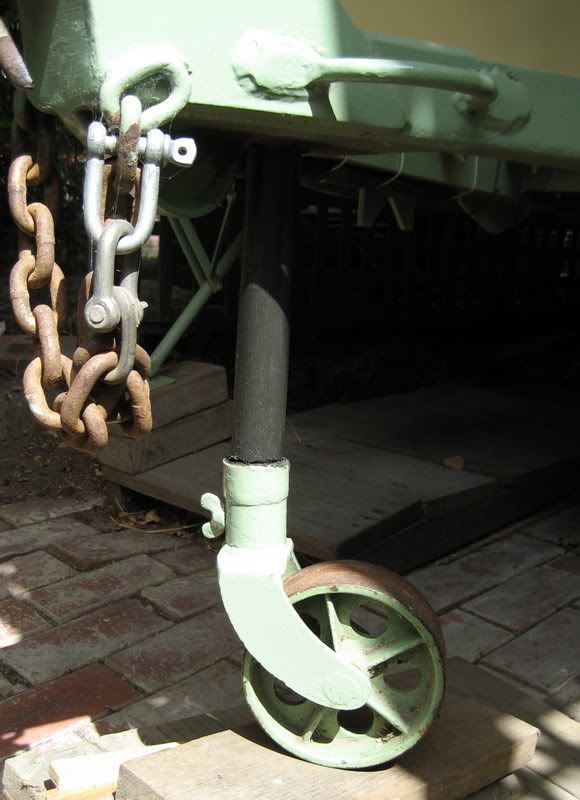 This is a photo of the jockey wheel mechanism and shaft, which is described in the Don sales brochure thus: “Patented jack-action caster wheel of telescopic tubing construction, with internal worm, eliminates all lifting when coupling to tow-car”. The jockey (caster) wheel is steel and is broad enough to make it surprisingly maneuverable even on fairly soft ground. 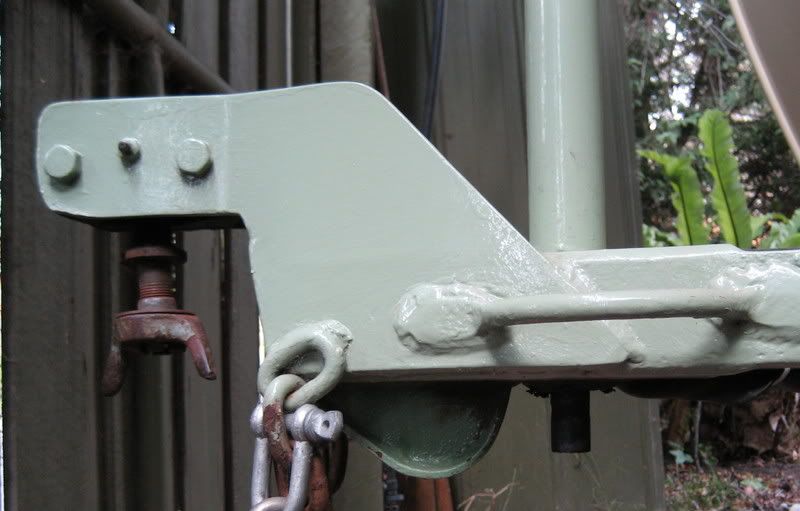 When the jockey wheel is taken off the shaft for travelling, the part of the shaft which is still exposed after full retraction, is protected from accidental damage (eg someone dropping the van!) by a large lug that is welded to the apex of the A-frame. The A-frame and head of the frame on Mark’s 10’ Don is exactly the same as the above, except for the jockey wheel mechanism, which I am keen to see at some stage. Don described it in their brochure as “Retractable steel caster wheel adjustable in height”.vintagecaravans.proboards30.com/index.cgi?board=general&action=display&thread=1132112802As far as I can tell from the photos of Mark’s Don Cadet though, Don appears to have started to use a more conventional tow coupling for the Cadet model (late 50’s). |
|
|
|
Post by cobber on Mar 22, 2007 11:06:48 GMT 10
G’day Don, Your right when you say ol’ 36’s coupling and over ride brake set-up is not that different to those we see from the late 50’s onward, but as I have mentioned previously the coupling patent was granted in 1934. Apart from not having a hand brake as a standard fitting there is no “blocking” lever to prevent the brakes from operating when reversing. There is a spring in the space where a “blocking” lever would normally go and that does the job...sort of. The jockey wheel is a different story I suspect. I think it may have been an addition sometime in the 50’s, and most likely a one-off home made type of arrangement. The wheel itself is solid hard rubber 6 inches in diameter and 2 inches wide, it is branded “Kenworth”. ( IT WAS LATER DETERMINED THE JOCKEY WHEEL BRAND IS ' HENDERSON' FROM AROUND 1954 ) 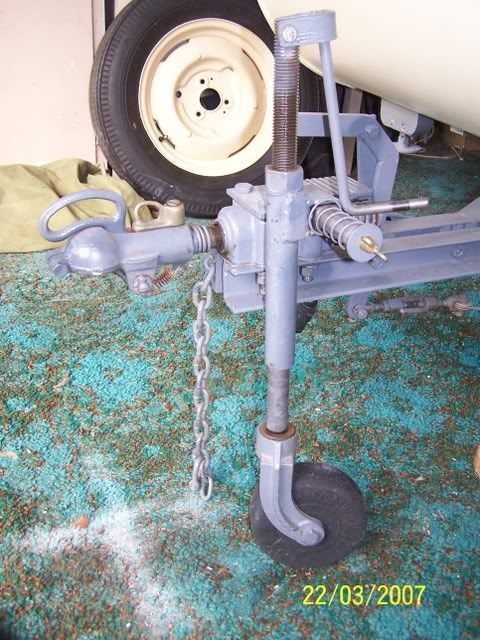 Photos I have of English vans of the 30’s suggest many jockey wheels at that time had no means to raise or lower the van, some did, they were still experimenting maybe ? I hope this photo shows clearly how simple it is to tuck the jockey wheel up out of the way.. the square socket, that is an integral part of the worm and nut column, pulls out against the spring until it reaches the round part of the shaft.. turns 90 deg. then slides back onto the square part of the shaft, it works well. 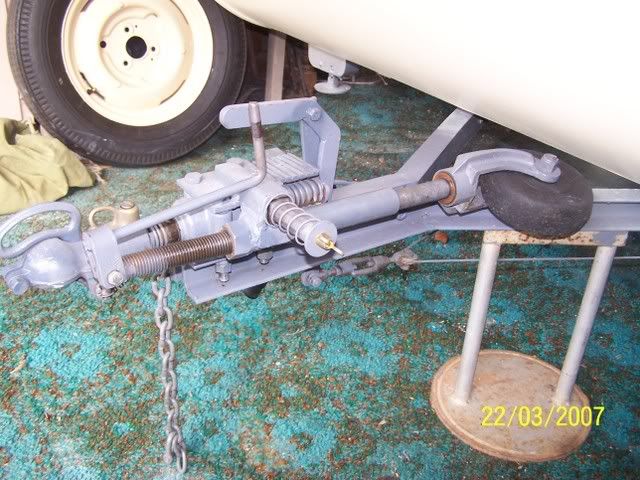 Solid rubber wheel 6” x 2” off a Kenworth truck  ;D.  Are you saying Don, that Don caravans persisted with the captive ball in the socket arrangement from 1934 until 1955, I suppose it was possible to remove the ball by undoing the two bolts, or did this just release the whole assemble from the “A” frame ? The photos of Marks Don couplings are not very clear on his thread.. It would be good to see clearer photos on this thread eh ? Cobber. |
|
|
|
Post by Don Ricardo on Mar 24, 2007 21:10:21 GMT 10
Hi Cobber, Thanks for the extra information on Ol' 36's tow coupling, and for posting the additional photos, which are really good and clear to look at. I guess it goes to show that when it comes to caravans, some things haven't changed very dramatically at all - as shown by your coupling - while other things have changed quite significantly (but not always for the better!). I was interested in your comments about the blocking lever. I hadn't picked that up from the earlier photos - although now that you mention it, it is pretty obvious. One thing that puzzles me though - if the spring is strong enough to prevent the brakes being applied when you're reversing, why isn't it strong enough to prevent the brakes being applied when you are traveling forward then stop? Maybe that's why you said "...sort of" in relation to reversing?? The jockey wheel arrangement is pretty clever too, and not all that different from the 'swing up' jockey wheels you see on some modern vans and trailers. One thing though - I thought Kenworths had bigger wheels than that! Maybe Kenworth also manufactured jockey wheels etc as well as trucks at some stage? Perhaps an enquiry to Kenworth might help date the jockey wheel? Are you saying Don, that Don caravans persisted with the captive ball in the socket arrangement from 1934 until 1955, I suppose it was possible to remove the ball by undoing the two bolts, or did this just release the whole assemble from the “A” frame ? After I read your question I did a bit of research by looking at the various photos I have of Don caravans. Unfortunately most don't provide very clear photos of the tow coupling as you commented. However, I think I can confirm that Don did use the the 'captive ball' arrangement from very close to 1934 to at least 1957, subject to any information others may be able to provide. I have re-scanned the photos of the Walsh's 1936 Don (Caravan World, November 1993) to focus on the tow coupling, and made the images a little lighter. The full article was posted in the thread: vintagecaravans.proboards30.com/index.cgi?board=general&action=display&thread=1171804732You can see from the photos that the A-frame on the '36 van appear to use lighter materials and a differently constructed 'tow head' compared to the later vans such as ours. However, you can also see that the van also used a 'captive ball' arrangement: 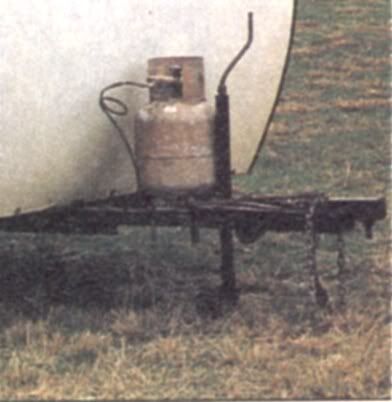 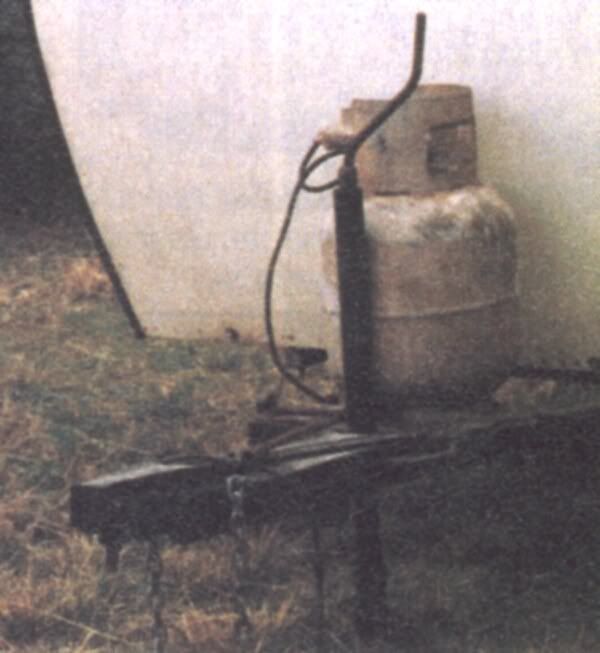 The characteristic Don lift handles on the A-frame are also visible, but the gas bottle and chains would have been later additions. Now for the 'piece de resistance', as my French friends would say... If you look at the advertisement for the 1957 Don Model 150 that Mark posted about two years ago, you will see that the A-frame and tow head are almost identical to those used 10 or 15 years earlier, including the 'captive ball': vintagecaravans.proboards30.com/index.cgi?board=Memorabilia2&action=display&thread=1118840316The Model 150 (which, using Don terminology, I think means that it was between 15' and 16' long) was introduced in 1956 or thereabouts. The Don Cadet, which Mark has, followed the Model 150 and seems to have been more similar to other vans of the same era, compared to its predecessors. As far as I can tell from the photos of the Cadet, it appears to use a more conventional tow coupling, but Mark will need to confirm (or refute) that for us. (Photos would be great Mark, if you are able to manage them at some stage!) Cobber, you asked about removing the ball. As you can see from the photos of the 'tow head' of our van, the ball is sandwiched between two pieces of steel which are then held in place by the two bolts. To remove the ball you would have to disassemble the whole caboose, but you would only do that if you had to inspect or replace the tow ball. It would not be an everyday activity. As far as I know, ours has never been taken apart in its 57 years. I'm not sure whether that's a good thing or not!! The 'captive ball' system means that it takes quite a number of minutes to connect the van to the car. After lining up the tow ball with the hole in the tow bar - which also means lining up a notch in the shank of the tow ball with a pin on the tongue, you need to lower the van until the tow head and tongue are aligned, insert the 'wedding ring', then tighten up the wing nut with the mallet and piece of 2 by 1. The wing nut needs to be absolutely tight or else the van gets a bit twitchy when traveling. For safety's sake a split pin is inserted through a hole in the tow ball bolt so that the wing nut has no chance of working loose and being lost on the road... (The notch in the shank of the tow ball, the 'wedding ring' and the split pin are all little modifications to our van over the years which have added to its stability on the road.) The 'captive ball' system is not quite as easy or convenient as the conventional coupling with the tow ball attached to the car tow bar!! Makes you wonder why Don persevered with it for so long doesn't it...? But then, it gives me something to do when I'm holidaying, and you and I something to compare notes about! One last comment - I'm VERY impressed with the way you look after Ol' 36! Not many V V's I know have carpeted accommodation! You obviously take your curatorial responsibilities very seriously! Every V V around the country will be asking for higher quality digs from now on!! Regards, Don Ricardo |
|
Deleted
Deleted Member
Posts: 0
|
Post by Deleted on Mar 25, 2007 0:29:39 GMT 10
|
|
|
|
Post by cobber on Mar 25, 2007 17:34:23 GMT 10
Mark, that spanner's pretty nifty....does it work ? You'd have to have it on the other way around if you were tightening the wing nut wouldn't you   I applaud your decision to persevere with the original coupling arrangement.... the only way to go eh? Now.. about the spare wheel.. what are both you and I going to do in that regard. Ol'36 has nowhere to mount a spare because back then I think the idea was that the tow car and the van had the same wheels and the cars spare wheel was also the vans spare wheel. I'm trying to convince myself that it's OK to make a bracket under the rear of the van to carry a spare, but if I get too much flack from the "unwashed purists" on the forum I might just have to carry it on the back seat of the FJ, because it takes up too much room in the boot. What do you think  Cobber. |
|
|
|
Post by Don Ricardo on Mar 26, 2007 0:32:27 GMT 10
Hi Mark, No, Don didn't provide a tool to stop the shank turning around when tightening the wing nut - well not as such anyway. The answer to your question lies in the notch cut into the collar of the ball, which you can clearly see in your photo above the thread, and you can also see in one of my photos of the shank and collar. (Being basically non-technical, I'm finding it hard to find the terms to describe what I'm talking about, so if I'm not making sense tell me!) The notch in the collar is intended to fit around a pin on the tow bar tongue, and it is the pin which stops the shank from turning when tightening the wing nut. The pin on the tongue not only holds the tow ball steady while you're trying to tighten the wing nut, but as I said in my post yesterday, it also plays an important role in keeping the tow ball from jiggling around while traveling, and in turn the van is also more stable. I'm not sure why this is, all I can tell you that on occasions when I've been towing the van without the pin in place, it's a far less pleasant experience. I remember that on our early tow vehicles, the pin was in fact a pin welded on to the tongue (I guess a hole was drilled into the tongue, the pin inserted, then welded into place). A later tow vehicle had a hole drilled into the tongue and threaded. This allowed a small bolt to be screwed into the hole. The bolt had had its head taken off and then a groove cut into it so that it could be screwed in and out with a screwdriver. This was a good arrangement for reasons I will explain shortly. Our current tow bar has a piece of steel rod welded onto the tongue in the correct place (just north of the closest hole), which I hope you can see in the following pic. The notch in the collar of the tow ball fits around this: 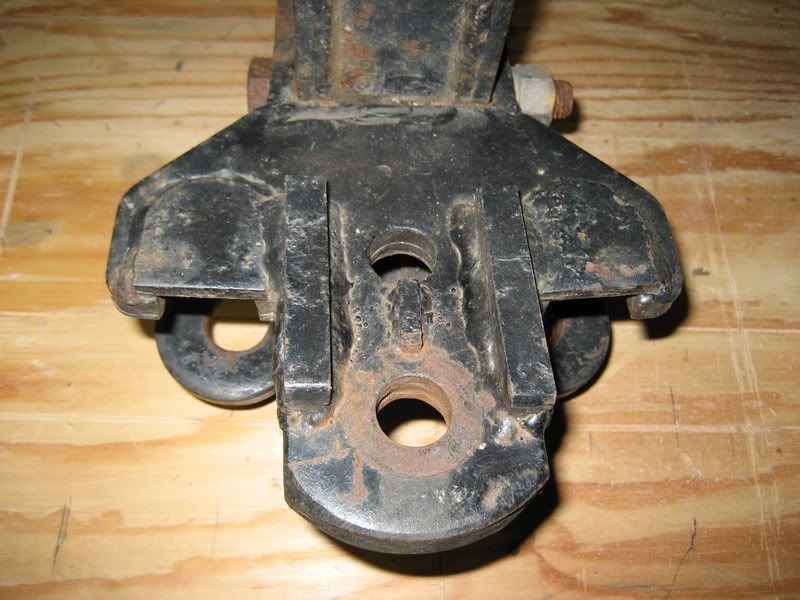 Ugly piece of work, but it operates well with our van! Now, it's probably occurred to you that having a pin on the tow bar tongue to accommodate your Don(s), will mean that you can't use the tongue to tow something else. There are three solutions to that, and at different times we've used all three - all three work: (1) Have a second ordinary tongue for non-Don usage. (2) Get a notch cut into the collar of your other towballs. (3) This is the most ingenious solution, and I referred to it above - arrange for the pin to be threaded so that you can take it out when you're not towing a Don!! I agree with your comment, Mark, about not changing the tow head on your Dons. My view is that the Don system was so unusual (maybe even unique?) that it just wouldn't be a Don without it. All the same, I sympathise with your comment about uncoupling a Don when it's on an incline - the road outside our house is on an incline so we face this issue every time we're hooking up to go away or uncoupling after coming home. However, I'd have to say with a bit of practice it becomes easier. My answer is to have the caravan well chocked and two people to do the job. My sons and I have become reasonably adept at backing the car up to the van with one person guiding so that the tow ball shank and hole are lined up within two or three millimetres. We then lower the shank into the hole, nudging the van in whatever direction is required with our backs against the front wall to achieve 100% alignment. We also usually need to nudge the van a little when tightening up the wing nut so that the shank is vertical and not on an angle. Doesn't take much to push the van into the right position, even up the incline - you're just looking for a few millimetres play. Sounds like a lot of muckin' around, but really you get so used to it, you think that's what everybody does! By the way, thanks also for the photo of the spare wheel mount. It's interesting to see a close up of how it's put together. Somebody had a bright idea at some stage. I guess it was made to use with any number of vans providing they had a reasonably secure jockey wheel assembly. Hi to you also Cobber (and Happy Birthday),One question about mounting the spare tyre under the rear of the van. Sounds like a good solution, but wouldn't the weight under the rear cause problems with the weight distribution of the van, and hence affect stabililty during towing? A spare wheel is reasonably heavy, particularly if it's hanging on at the far end away from the car. Regards, Don Ricardo
|
|
|
|
Post by cobber on Mar 26, 2007 12:29:47 GMT 10
G’day Don, Firstly.. thank you for the Birthday wishes. Secondly.. the spare wheel mounted under the rear of ol’36 would be a decided advantage. She has 98kg bearing down on the tow ball at the moment which is about twice the recommended load, which should be about 10% of the vans total weight. I think I may do as Col has suggested, mount the tyre under the floor, at the rear, and not let on to anybody that it’s not the way it was originally. I am intrigued by the fact that “Don” went to so much trouble, to put “Don” owners to so much trouble, to make sure that the ball was located in just the right position in relation to the socket on the caravan...and as you say, if it wasn’t in that precise position the van behaved much less predictable. Has anybody ever pulled the assembly apart to determine that the “ball” is in fact simply a perfectly symmetrical “ball”, or even just spin the ball by hand to see if this is the case. I know, it sounds like a silly question to me too, but who else goes to that much trouble to stop the ball turning in the tow bar tongue, or the nut coming loose...it doesn’t happen, one just puts a spring washer under the nut, I usually don’t even do that, I just do the nut up tight... I mean tight, and it has never moved. The English, who take a morbid pride in their own eccentricity (no offence intended Brian), don’t seem to have had “captive” ball couplings beyond the 1930’s when the “Brockhouse” fitting was patented, if they had such fitting before the 30’s I don’t know for sure, maybe UK Brian can enlighten us, it would be interesting to know if “The Don” got it’s inspiration from the “Old Dart”. The illustrations below show a few couplings from a book published in the UK in 1951 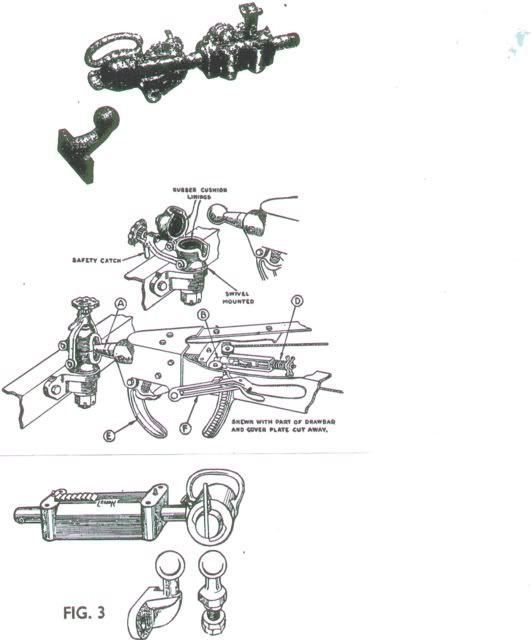 The top one is the Brockhouse showing that by 1951 it did have a blocking device to prevent the brake operating when backing. The middle illustration shows, amongst other things, a bracket (e) that would automatically apply the van brakes as soon as the bracket hit the ground. The same book indicates that override brakes were required in England on any trailer weighing more than 2cwt, that is a weight much less than our authorities demand the fitting of brakes. You noticed the carpet under ol’ 36 Don...... nothing less than she deserves I reckon. Cobber. |
|
|
|
Post by Don Ricardo on Mar 26, 2007 21:52:21 GMT 10
I am intrigued by the fact that “Don” went to so much trouble, to put “Don” owners to so much trouble...who else goes to that much trouble to stop the ball turning in the tow bar tongue, or the nut coming loose... Nicely put Cobber!! There must have been a reason. According to the explanation in the Don sales brochure: ' COUPLING
"DON" ball-coupling built into chassis head, designed for extreme lateral and longitudinal movement, with special safety features: coupling ball of alloy steel heat-treated and tested to 70 tons per square inch tensile strength; fitted with Zerk greaser for lubrication."' Somebody with more engineering understanding than I, might like to venture an opinion on whether the captive ball system does actually provide more lateral and longitudinal movement than other systems. It my be possible that the Don system could provide more lateral movement than say the coupling in your middle illustration, but I don't see any advantage over, say, the Brockhouse coupling. Just for the record, I've just spun the tow ball around on our van, and it does appear to be a perfectly symmetrical ball as far as I can sense with my fingers. As for the question about who else goes to that much trouble - someone who designs a system in which the ball has to be bolted and unbolted every time you use it! You can't just depend on the user doing up the bolt tight every time. Doesn't answer the question about 'why that system' though does it? Don Ricardo |
|
Deleted
Deleted Member
Posts: 0
|
Post by Deleted on Mar 27, 2007 1:21:58 GMT 10
Don R, Thank you for your detailed & technical explanation of how the Don coupling works ...... but, unfortunately you have depressed me   WHAT A NIGHTMARE !!!!     Why make something so easy, SO DIFFICULT !!! I must point out that I have done very little towing of a Don caravan to date.........and after your detailed explanation of how it all works, I doubt that I'll be doing much Don caravan towing at all   ;D As for towbars & tounges shanks & pins etc, I use any one of several cars to tow the caravans, just depends on what car is around at the time, therefore the shank & pin thing just ain't going to happen  AND ......90% of the time when I shift a caravan for whatever reason, I'm on my own, and just don't have three men available to manouvre the caravan to exactly align the towball shaft & hole-in-the-tounge ......the conventional set up works well for me coz its "hit & miss"  Now, ........... where's my oxy ;D ;D Mark ps: You wouldn't happen to know where I can one of those big wing nuts do you  ......you'll never guess what happened to me  ......... The day we picked up the little 10' Don from the truckie's yard (following its trip accross the nullabour) we hooked up the caravan, removed the NORMAL towbar from the tounge of the car, dropped the "Don" thingy in the tounge hole, tightened the wing nut and drove off down the road .......all good  Bout 2 kms later, the litte caravan started jumping around violently on the towbar ..........you'll never guess what had happened ........DUH ......the wing nut had worked it way loose and gone South  ........I wonder why  Anyway, I walked the two kms looking for the wing nut, coz the caravan was untowable without it .......I never found the wing nut, ... and the jumping up & down of the shaft in the tounge hole, stripped the thread on the shaft anyway  $120 later, ..... after a ride on the back of a tilt tray truck, the little Don was safely home  |
|
|
|
Post by Alan, Jenny & Marvin on Mar 27, 2007 7:27:24 GMT 10
Hi All, Here are some photos of Marvin's coupling setrup. He has a captive ball under his snout, permanently held in by a ring secured by 6 bolts. 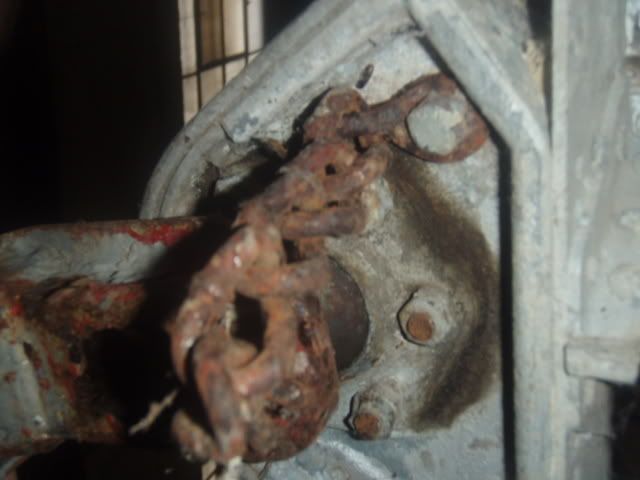 The ball is attached to a yolk with a face plate for coupling to the tow vehicle. 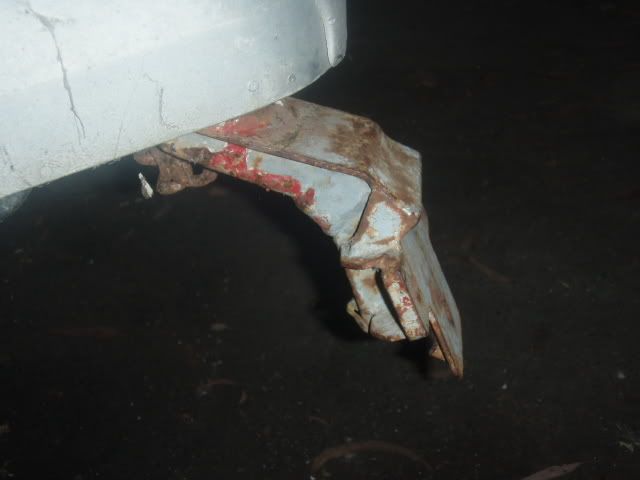 This fits onto another plate on the yolk of the towbar, and is then secured with 3 bolts for towing. 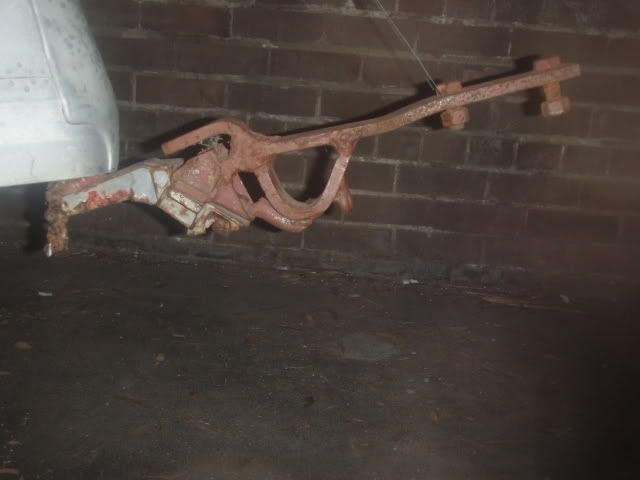 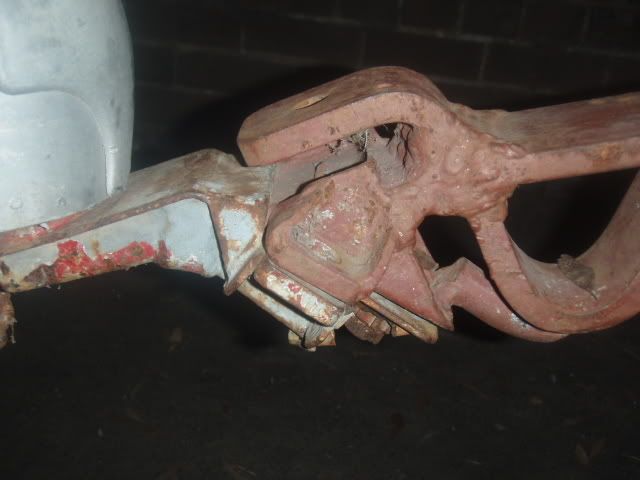 The plate attached to the caravan has a locating lug to simplify the process of hooking up. I have not actually tried it yet, but it looks as if the van (very light) could be manouvred to the tow car and the lug would slide easily into place and sit on the yolk while the 3 securing bolts are tightened. I still haven't decided whether I will keep this setup as it has 3 major problems: The van sits very close to the tow vehicle and Marvin has dents on both sides which have probably been caused by reversing jack-knifes. There is nowhere to attach a dolly wheel or a gas bottle. The section of the coupling attached to Marvin is seriously affected by rust, and is unlikely to be replaceable. It is, however, an interesting setup. Alan |
|
|
|
Post by cobber on Mar 27, 2007 8:48:21 GMT 10
Thanks Alan, For adding a bit of variety to this thread. There has to be many unique ways of hooking a van to a tow bar out there, and its interesting to see the ways it has been done during the development of the industry. I can't say I understand how "Marvins" actually works, the angles all seem wrong......but then I just had another look, and I think I see a bit of wire holding the tow bar tongue up in the air...right? So to disconnect Marvin from the car you either have to undo the three bolts holding the face plate to the yolk  ...or undo the two bolts securing the yolk to the tow bar  .....or undo the bolts holding the tow bar to the car  ....no, there must be an easier way. At a rough guess, would you say this whole set up is a one off, home made arrangement Alan, although the part you say is badly affected by rust appears to be a pressed metal thing, is that right? You say there are only three major problems to discourage you from keeping this interesting coupling...I see only two minor ones  (1) the jack-knife problem just means you have to be careful when doing tight turns (2) the rusted coupling is just another part of the restoration process, replace it. ... that’s it, you really wouldn't contemplate putting a gas bottle on " Marvellous Marvin" if he didn't have one to start with..... would you   Cobber. |
|
|
|
Post by Alan, Jenny & Marvin on Mar 27, 2007 9:04:34 GMT 10
Hi Cobber,
I wasn't really thinking about putting gas into Marvin, but a dolly wheel would be handy.
The rusted piece is definitely not home made, nor is the small piece that attaches to it. The welding of this piece to a standard towbar yolk has been done by someone with little skill.
As for simplicity, I think it would be easier than the 'Don' process, although it does require 3 rather than 1 bolt to fix it.
Alan
|
|
|
|
Post by Don Ricardo on Mar 27, 2007 21:11:37 GMT 10
Wow Alan and Jenny,
What a set up. I don't think I've ever seen anything like it... Like so much of Marvin, the coupling is quite different to the norm and shows some really alternative thinking. Even with the locating lug, it looks as if hooking up Marvin would take a little bit of time. I'm presuming that the principle behind the design was that when Marvin was in use he would stay connected to his tow vehicle, not be unhooked at the end of a day's travel and then reconnected the next morning as very often happens. Is that how you read it??
I understand the need for a jockey wheel, but it would be a shame to lose this unique element of Marvin's design if you can help it. (Mind you it's all very well for me to say that - I'm not the one who has to hook him up on a regular basis!!)
Thanks for the photos and the explanation. Keep us in the loop as you decide how to proceed.
Don Ricardo
|
|
|
|
Post by Don Ricardo on Mar 27, 2007 21:57:20 GMT 10
G'day Mark,
Sorry to hear about the results of the lost wing nut, as well as the fact that I have discouraged you from touring with the Dons.
Actually, you shouldn't get too depressed about hooking up a Don. Although I mentioned it helps having two people, I have hooked up our caravan many, many times by myself and don't have any qualms about it. The most difficult bit by yourself is lining up the tow bar with the van, but I think that probably applies to any van when you're doing it solo. If you're on reasonably flat ground it's a piece of cake - just takes a few extra minutes compared to a more conventional coupling.
Regarding the pin on the tow bar tongue, I'm not sure what sort of tow bar you use on your vehicles? Our car is fitted with a Hayman Reese 'hitch receiver' tow bar, which is the one you see with the square tube to receive different tow bar tongues. This means that we have two tongues. One with the pin for the van, and the other a standard tongue we use for trailers or the bike rack, etc.
If you don't have this type of tow bar, then the simplest solution could be to use the arrangement I mentioned with the little bolt which screws in and out of a threaded hole in the tongue. When you're towing one of the Dons just screw in the bolt.
With the wing nut, I'm not sure whether that type of thing is widely available. We used to have a box of things like that on our farm when I was a kid, but that's not much use to you now!! If you can't locate one perhaps you could get a couple of flanges welded onto a standard nut?
Just out of interest, does the shank on the tow balls on your various Dons - including the 10' - have a hole drilled in it for a split pin to be inserted to prevent the wing nut going on it's own little holiday? I notice from the photo in your post above that the wing nut on your 14' van has the little flanges on the bottom side of the wing nut to allow a split pin to be inserted, so I am assuming the hole is in the shank??
As an aside to this discussion, in days gone by, I used to be able to back my car up to the van with a high degree of accuracy by looking in the rear vision mirror and lining up the jockey wheel handle with the little manufacturer's mark that they used to put at the bottom edge of the rear windscreen in the centre (usually a little brown coloured seal). Onlookers used to think I was really smart!! On my last couple of cars though, the rotters have deleted the manufacturers mark, which makes it harder to line up the van. I bet there are a few VV'ers out there who used to use the same method...
Don Ricardo
|
|
Deleted
Deleted Member
Posts: 0
|
Post by Deleted on Apr 6, 2007 23:30:18 GMT 10
|
|
|
|
Post by Don Ricardo on Apr 7, 2007 0:34:45 GMT 10
Hey Mark,
Thanks for posting the photos of the tow coupling on your Don 10 footer. It's fascinating! So much is so familiar, but the jockey wheel arrangement is distintively different from the larger vans. Can you explain how you use it? I assume the knurled knob screws into the dimples on the shank to secure the jockey wheel at a particular height, but how do you raise and lower the van, and where does the handle on top of the shank fit in?
Re dating caravans by Victorian number plates (and I'm sorry if I'm repeating stuff you already know here):
From memory, up until some time in the mid 60's, caravans and trailers in Victoria didn't have to be separately registered. It was sufficient for them to display the registration number of the tow vehicle. However, in the mid-60's (not sure exactly when - maybe 1965 or 1967 - someone out there will know), a law was brought in which required caravans and trailers which were wider than the tow car (and/or over a certain weight, currently 200 kg) to be individually registered. There was a 12 or 24 month transition period allowed for registration, and in our case my mother (who owned our caravan at that stage) waited until fairly close to the end of the transition period. As a result our caravan rego number began with the prefix 'G65...'.
Trailer/caravan number plates began with 'G' because under the allocation of number plate series around Australia in the 50's, Victoria was allocated 'G' to 'M'. So... when they began to register trailers the first plates were 'G' plates. I assume that the first trailers registered would have been G00... or G10..., but I have no evidence of that.
In any case if you have a caravan registered with a 'G' plate you know it was registered separately for the first time in the mid-60's, although of course that doesn't tell you anything about the age of the van itself...
(As an aside for Reddo - caravan registration in Victoria is remarkably cheap. Full registration for our caravan last year was in the vicinity of $35, compared to the $160 you quoted for NSW.)
Now going back to your 10 footer with the Victorian number plate AB-898, as indicated above this was the registration number for the caravan's tow car. I can tell you that the tow car was pre-1936, because my father had a 1936 Chrysler with the number plate AK something or another (AK-584 if I am not mistaken). Again this doesn't tell you anything about the age of the caravan as such, but at least it may give you a very small clue as to its history.
Again, sorry if I am telling you things you already know, but it is probably better to share information than just assume that everybody else already knows it!!
Thanks again for the photos. Looking forward to hearing more about the jockey wheel mechanism.
Don Ricardo
|
|
Deleted
Deleted Member
Posts: 0
|
Post by Deleted on Apr 7, 2007 1:07:47 GMT 10
Don R says: "I assume the knurled knob screws into the dimples on the shank to secure the jockey wheel at a particular height." Correct Don R .......it's that simple. But how do you raise and lower the van? The van is that light on the drawbar, its a one man "lift on lift off" operation. I manourved the little Don today into sunlight to take the pics. It was sitting on an axle stand, the van is that light, I just lift it up, unscrew the knob, let the shaft drop down to ground level, and tighten the knob.......easy  where does the handle on top of the shank fit in? The handle at the top of the jockey wheel shaft is for manourving the van, one hand on the handle, the other on the corner handle attached to the front of the van. Thanks for clarification of the No plate, Arthur Pullin did once explain this to me. (caravan having the same No of the car). But to be able to roughly date the tow vehicle from the No plate, is good info to know. My 1949 FX Holden has its original No plate "NO 222". Mark |
|
|
|
Post by firefighter on Apr 7, 2007 8:29:57 GMT 10
    HI Mark & Don Victoria had enamel no plates up to june 1939 , july 1939 was the start of the series with letters A A OOO with vic down the side ( pressed plates ) Don your dads 1936 chrysler A K 584 must have been re regristed ( maybe after the war ) ? because in 1936 the no plate would have been all nos and the plate would have been enamel I have just sold enamel no plate with 5 nos on it an old bloke to put on 36 chrysler air flow ( de soto ) I have a book on aust no plates will try to put a page on that covers the years 1939 till 1970 vic if not I will e mail them to you Don & Mark    Geoff ;D ;D ;D ;D
|
|
Deleted
Deleted Member
Posts: 0
|
Post by Deleted on Apr 7, 2007 19:44:33 GMT 10
thanks for that Geoff ......... so what year would've the tow vehicle for my 14' Don been?  You can just see a top small section of the "V" on the far left hand side of the plate. |
|
Deleted
Deleted Member
Posts: 0
|
Post by Deleted on Apr 7, 2007 21:30:47 GMT 10
Interesting stuff Geoff.
I have an timber chassis old buck board style box trailer with a dropped axle fitted with 17" four stud willys wheels .
Has a vic plate on the back.
It is about 4" (100mm) high X 10 "or 12"long . black background /white hand painted letters and numbers.
T.31-464. will post a pix of trailer and plate when i get a chance.
Can you shed any light on the year of rego??
was going to put the plate on the back of the TD as a novelty. But the local constabulary might take offence.
Regards
Reddo
|
|